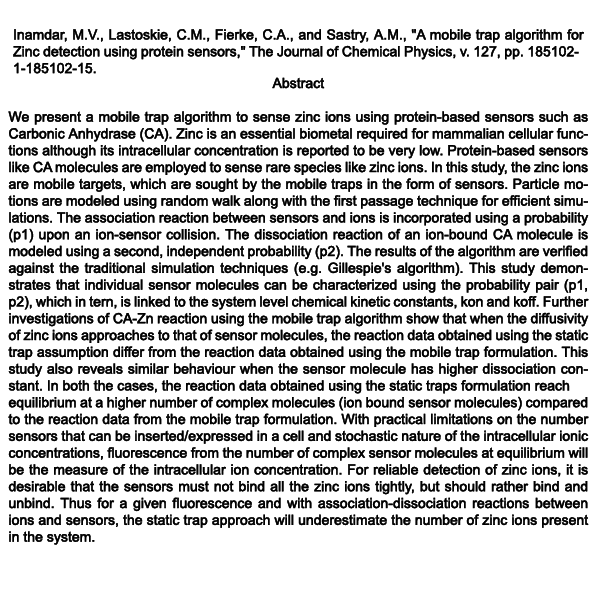Abstract
We present a mobile trap algorithm to sense zinc ions using protein-based sensors such as Carbonic Anhydrase (CA). Zinc is an essential biometal required for mammalian cellular functions although its intracellular concentration is reported to be very low. Protein-based sensors like CA molecules are employed to sense rare species like zinc ions. In this study, the zinc ions are mobile targets, which are sought by the mobile traps in the form of sensors. Particle motions are modeled using random walk along with the first passage technique for efficient simulations. The association reaction between sensors and ions is incorporated using a probability (p1) upon an ion-sensor collision. The dissociation reaction of an ion-bound CA molecule is modeled using a second, independent probability (p2). The results of the algorithm are verified against the traditional simulation techniques (e.g. Gillespie's algorithm). This study demonstrates that individual sensor molecules can be characterized using the probability pair (p1, p2), which in tern, is linked to the system level chemical kinetic constants, kon and koff. Further investigations of CA-Zn reaction using the mobile trap algorithm show that when the diffusivity of zinc ions approaches to that of sensor molecules, the reaction data obtained using the static trap assumption differ from the reaction data obtained using the mobile trap formulation. This study also reveals similar behaviour when the sensor molecule has higher dissociation constant. In both the cases, the reaction data obtained using the static traps formulation reach
equilibrium at a higher number of complex molecules (ion bound sensor molecules) compared to the reaction data from the mobile trap formulation. With practical limitations on the number sensors that can be inserted/expressed in a cell and stochastic nature of the intracellular ionic concentrations, fluorescence from the number of complex sensor molecules at equilibrium will be the measure of the intracellular ion concentration. For reliable detection of zinc ions, it is desirable that the sensors must not bind all the zinc ions tightly, but should rather bind and unbind. Thus for a given fluorescence and with association-dissociation reactions between ions and sensors, the static trap approach will underestimate the number of zinc ions present in the system.
